7 Steps to optimize your email marketing strategy for better email campaigns (Updated 2023)
Email remains one of the most powerful tools in the marketer’s toolbox, thanks to its unparalleled return on investment (ROI) of about 36 dollars for every dollar spent (HubSpot). However, it’s not as simple as throwing together a few words and images, sending them out at random, and sitting back while the dollars roll in. Instead, having a thoughtful email marketing strategy in place will help you avoid the most common mistakes agencies make while turning your email campaigns into revenue-generating machines for your clients.
Download our ready-to-use email templates to reengage old leads for free and scale your sales process today!
In this article, we’ll show you exactly how to create a repeatable email marketing process that delivers results by walking you step-by-step through every stage of crafting a powerful email marketing strategy.
Table of Contents
- Overview: Email marketing strategy basics
- How is the email marketing process different from other marketing functions?
- Examples of effective email campaigns
- Effective email marketing means segmenting your audience
- Establish clear goals for email campaigns
- Include sign-up forms in the email marketing process to capture the right data
- Consider the frequency of your email campaigns
- Effective marketing emails are scheduled for specific times
- Create engaging, relevant, and valuable content
- Test and optimize every campaign
Overview: Email marketing strategy basics
A savvy email marketing strategy gives your SMB clients a cost-effective avenue for communicating with their target audience, building brand awareness, and driving conversions. Before we get into the 7 steps for optimizing your email campaigns, let’s get reacquainted with the foundational stuff. By having these basics top of mind, you can start thinking about real email marketing projects you might already be working on, and how you can optimize them to get even better results.
What is an email marketing campaign, exactly?
An email marketing campaign is a targeted, coordinated series of email messages sent to a specific audience with the aim of promoting an offering. These campaigns can take different forms and serve varying purposes, like increasing brand awareness, generating leads, driving sales, or nurturing customer relationships.
By using strategies like audience segmentation, personalization, and performance analysis, agencies can create effective email campaigns that reach the right people with relevant, engaging content, resulting in higher open rates, click-through rates, and ultimately, better ROI.
While email marketing campaigns do require management, monitoring, analysis, and optimization, once you have a formula that works for a client, much of the email marketing process can be put on auto-pilot.
Components of an email marketing strategy
Email marketing strategies go beyond the copywriting and design that goes into creating an email. When creating effective email campaigns for your clients, each of the following points should be addressed throughout the life of the campaign:
- Audience segmentation: Email marketing strategies include the division of email lists into smaller segments based on demographics, behaviors, purchase history, or preferences. These segments enable marketers to send more tailored messaging to each segment, increasing relevance, click-through rates, and conversions.
- Personalization: In 2023 and beyond, personalization is not just a trend but rather an expectation when it comes to effective marketing emails (and digital marketing more broadly). Email content can be customized based on the recipient's data, like their name, location, or purchase history, to boost relevance and engagement.
- A/B testing: The email marketing process involves constant iteration to improve the effectiveness of email campaigns. A/B testing is the perfect way to do this, by testing different elements of an email to optimize future emails. A/B testing might test out subject lines, images, copy, calls to action, and even button colors to identify what works best.
- Analytics and tracking: No effective email marketing strategy is complete without the tracking and analysis of data. Analytics can reveal important metrics, such as open rates, click-through rates, and conversion rates, to measure the performance of your campaigns and help you make data-driven decisions for improvement.
Essential email marketing tips
Before hitting send on any email, go through this checklist of non-negotiable tips to make sure it meets the basic requirements of a successful email marketing campaign.
- Craft a compelling subject line: Use attention-grabbing and relevant subject lines to increase the likelihood of your emails being opened.
- Optimize for mobile devices: Remember that emails are likely to be opened on a mobile device, so ensure your campaign emails are mobile-friendly and look great on phones or tablets.
- Make sure your email list is cleaned up: Regularly update your clients’ lists to remove inactive subscribers or invalid email addresses, which can negatively impact their sender reputation and deliverability.
- Meet regulatory requirements: Adhere to laws and regulations in the geographic region in which your clients operate to make sure they don’t run into any legal issues.
The process of creating an email marketing strategy
Whoever your clients are, the same basic blueprint for creating an email marketing strategy applies. Once you have these down, add our optimization tips, and you’ll have a foolproof formula for email campaign marketing success.
- Set goals: Collaborate with your clients to define the objectives of your email campaigns, which may be increasing brand awareness, generating leads, or driving sales, for example.
- Build an email list: Email campaigns can only be sent to people who have consented to receive emails. This means you’ll need a process for collecting legitimate sign-ups, such as a website form or lead magnet.
- Design email templates: Every client will have their own branding and visual identity. Creating a few visually appealing and responsive email templates that align with the brand and can be regularly reused will save you the effort of having to design new emails from scratch all the time.
- Determine the writing style: Email copy should be informative, relevant, valuable, and reflective of the brand voice that subscribers expect. Creating guidelines for copywriting will make it easier to craft effective email campaigns down the line.
- Create a schedule: Through email automation, email campaigns automatically send messages to recipients on a set schedule, or upon certain actions being taken. The creation of an email marketing strategy includes determining what this schedule will be.
- Test and iterate: Create a plan for what analytics will be evaluated, and how they will be used to optimize future mailings. Create a plan for A/B testing and determine how observations will be used and recorded.
How is the email marketing process different from other marketing functions?
Email marketing is both older than many other marketing functions and, in some important ways, better suited to the future of digital marketing. Let’s take a look at how.
It offers direct communication with subscribers
By sending emails straight to the inbox of your target audience, you can establish a one-on-one connection that is more personal and engaging than other forms of marketing, like social media or paid advertising.
It’s permission-based
The permission-based model of email campaign marketing means that recipients must explicitly opt-in to receive communications from a brand. This consent-driven approach ensures that email messages reach people who have already demonstrated a genuine interest in a business’s offerings. In contrast, many other marketing functions, like SEO or PPC ads, rely on targeting prospects who may not have shown a direct interest yet.
This makes email campaigns effective in terms of speaking to a more narrow and relevant subset of prospects, but it also has important repercussions for the future of marketing. As privacy laws and expectations change, owned channels like email lists become increasingly important components of a future-proof marketing strategy.
The price is right
With relatively low operational costs and potentially high returns on investment (ROI), email marketing can be an affordable way for businesses of all sizes to reach their target audiences. In comparison, other marketing channels can require substantial investments with less precise targeting and audience engagement.
It offers impressive analytics
The email marketing process allows for robust tracking and analytics, making it easier to measure campaign success and make data-driven decisions for improvement. Key performance indicators (KPIs) like open rates, click-through rates, and conversion rates can easily be monitored and analyzed to optimize email campaigns continually. Some other marketing functions, especially in traditional media, offer much poorer opportunities to collect and apply data.
It’s highly customizable
Through effective use of segmentation, it’s possible to craft effective marketing emails that are highly tailored to recipients' preferences. This can help brands build strong relationships with their audiences and keep them interested.
It’s infinitely scalable
The email marketing process is highly flexible and scalable, enabling businesses to adapt their campaigns according to their specific needs and goals. As your SMB clients’ email lists grow, their email campaigns will continue to deliver results and ROI.
Examples of effective email campaigns
Want some real-world inspiration to get you excited about crafting your next email marketing strategy? These examples of effective email marketing campaigns have all the hallmarks of a winning, revenue-boosting strategy.
Snif
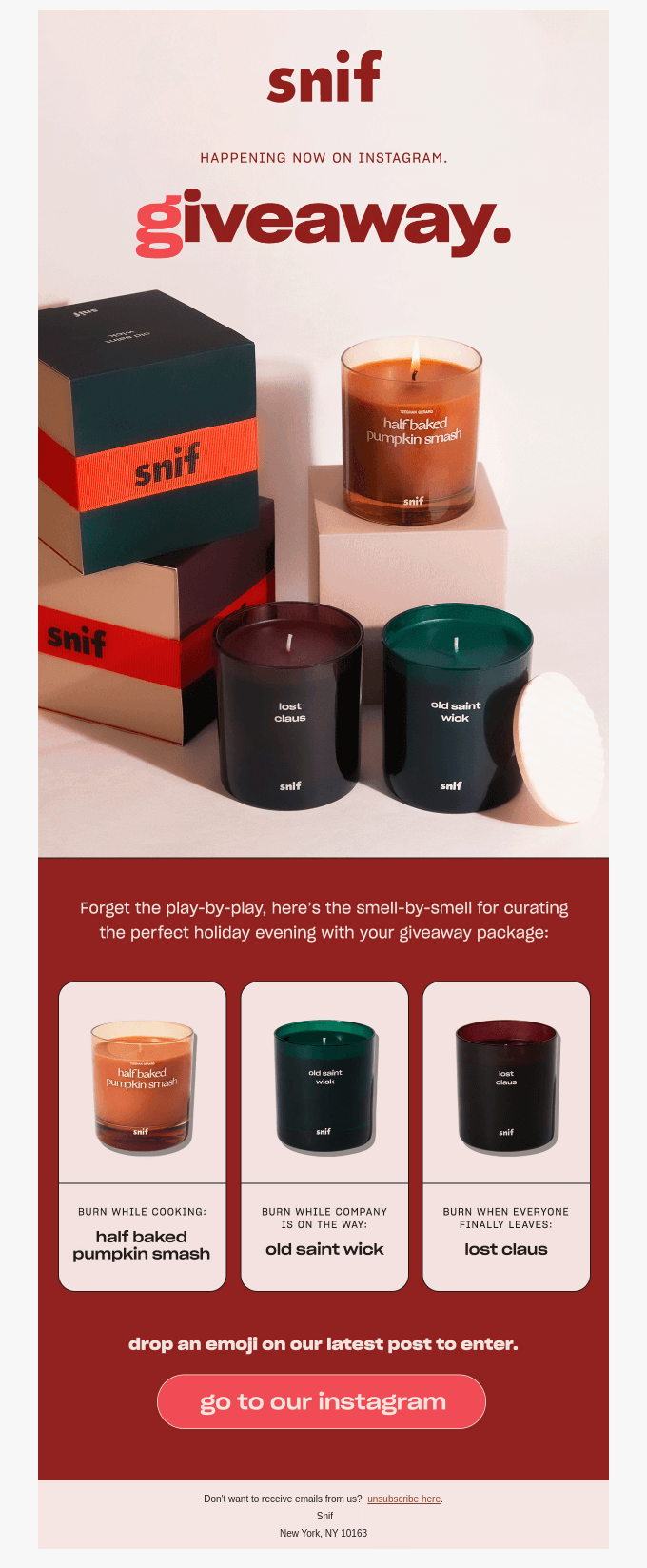
This email from Snif demonstrates how email campaigns can be used effectively in conjunction with other marketing channels—in this case, Instagram—to create a cohesive, multi-channel brand experience and encourage more engagement.
The CTA button says “go to our Instagram”, which is a perfect choice if the goal of this campaign is to gain more social media followers.
Bloomscape
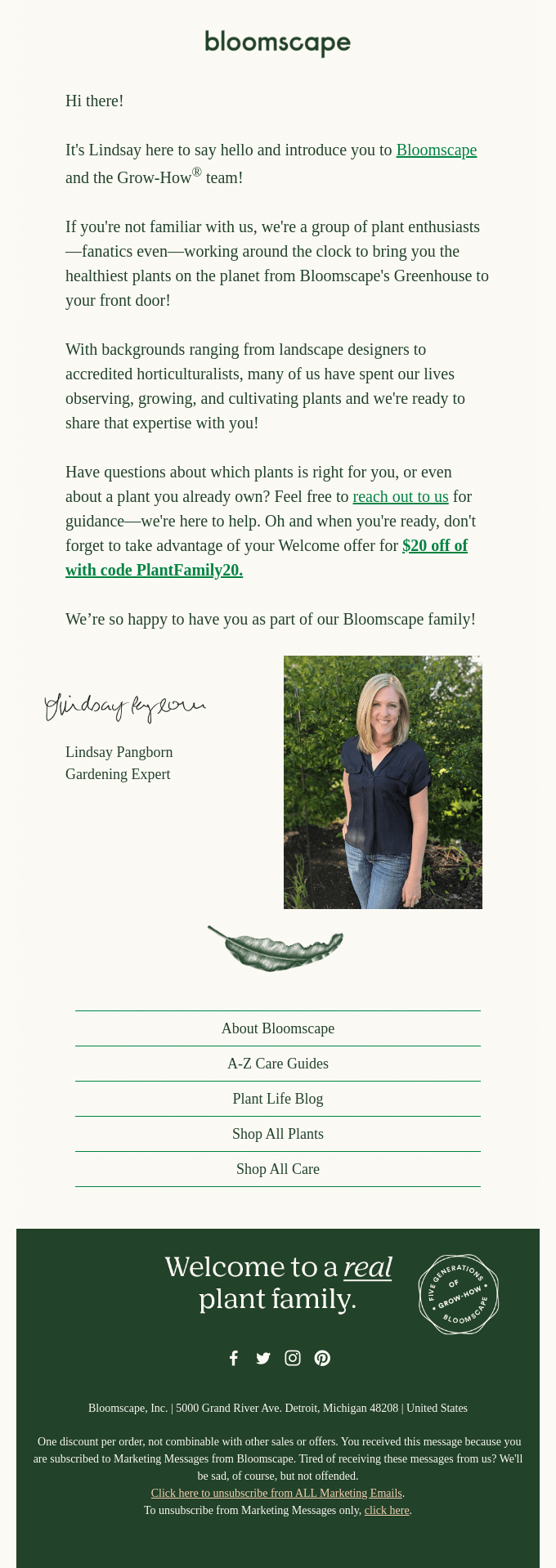
Bloomscape’s welcome campaign email demonstrates how this all-important first email can set the tone for the brand’s relationship with its customers, welcoming them into the brand universe and helping them get the lay of the land in terms of what they can expect in the future.
It includes links to the most important parts of the site, a friendly image, and a discount code nudging subscribers to make their first purchase.
Sellprop Auctions
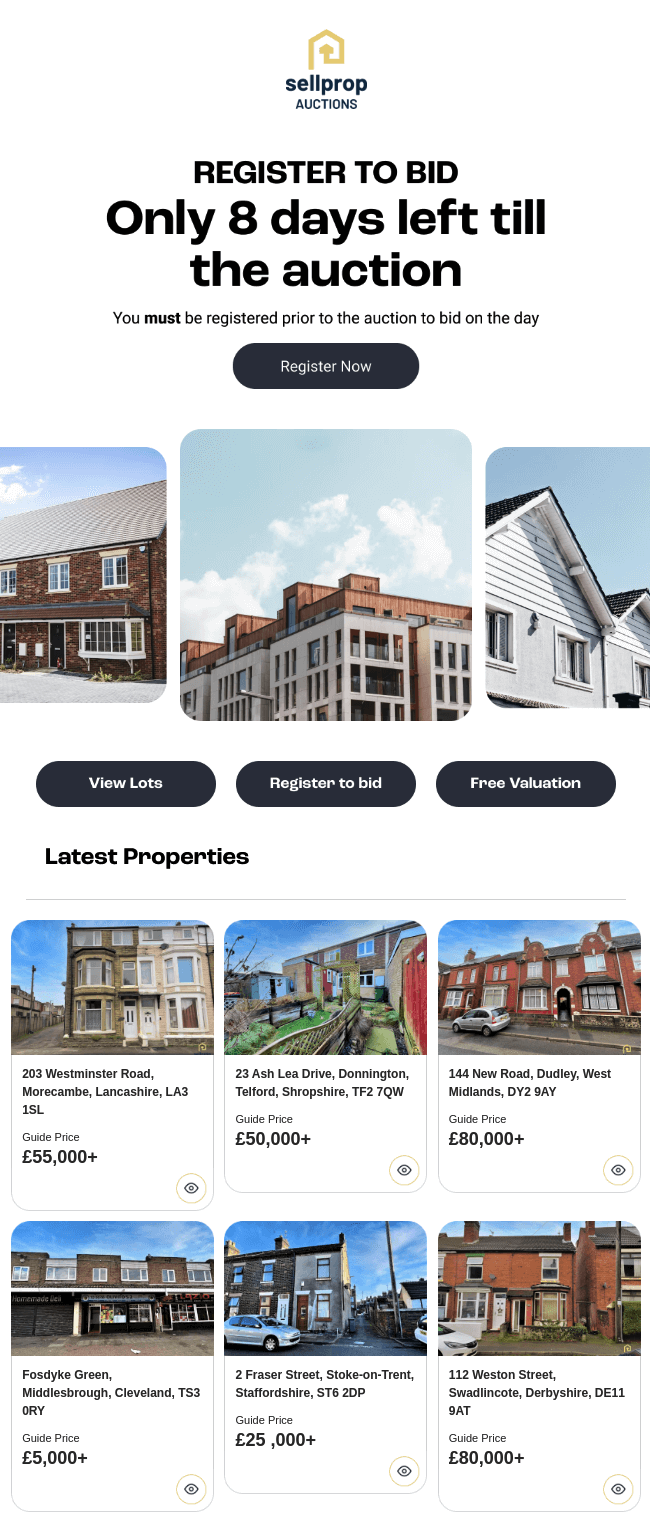
Sellprop Auction’s email campaign shows how dynamic sections in email templates can be used to maximize the effectiveness of an email. By having dynamic sections that auto-populate with the most recent information—in this case, properties—subscribers are more enticed to click and see what’s new.
1. Effective email marketing strategy means segmenting your audience
Whether you are a new or established agency, you will have prospects and existing SMB customers from different industries with varying needs and interests.
In order to target them effectively, Jordie van Rijn, specialist email marketing consultant at Emailmonday, says it’s vital to segment your audience from the get-go.
“Making your email segmentation more sophisticated is one of the ways to make a better match between your email campaigns and your subscribers. The end goal is to bring a plus to the bottom line while retaining ROI. So the segmentation model needs to have enough impact and represent viable groups of sufficient size,” he says.
He illustrates this with a high-level example (see the image below) from customer data management provider Optimove, which highlights that the value of targeting individual audience segments is superior to taking a homogenous approach to your whole email database.
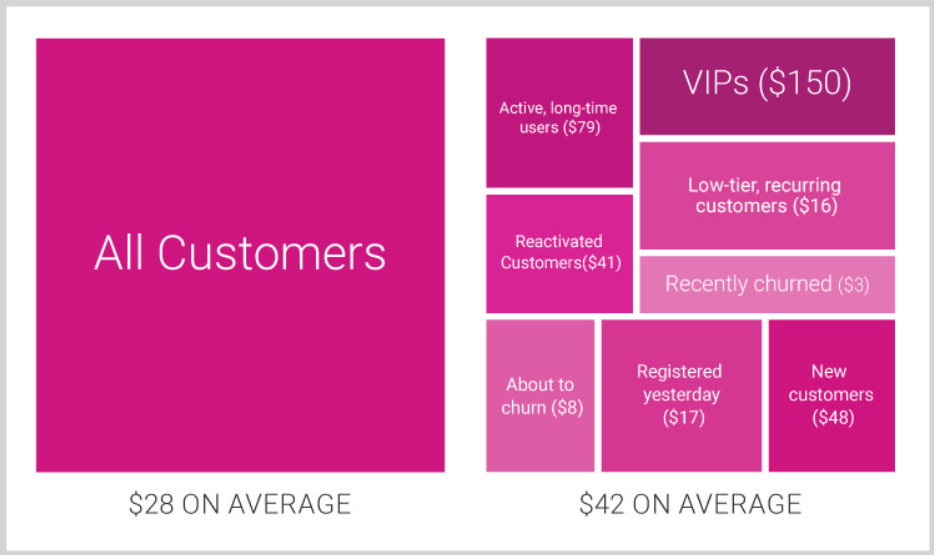
The image shows that a segmented marketing approach generates $42 in revenue per customer, compared to $28 for companies that send generic emails to their whole audience. “What you see in this overview of (RFM) segmented groups is that the group VIPs is the most profitable with $150, very different from the ‘recently churned’ group with $3," Rijn says.
In other words, marketers must grasp that sending the same campaigns to everyone on their list would prove ineffective as not all clients and leads are created equal. Therefore, audience segmentation should be one of the first exercises undertaken within email campaign marketing strategies.
Not only will your revenues grow when you segment your audience, but your metrics are likely to increase, as underscored by the following graph from eMarketer. It shows that 39 percent of marketers who segmented their email lists experienced increased open rates, 28 percent saw lower unsubscribe rates, and 24 percent found better deliverability and greater revenue.
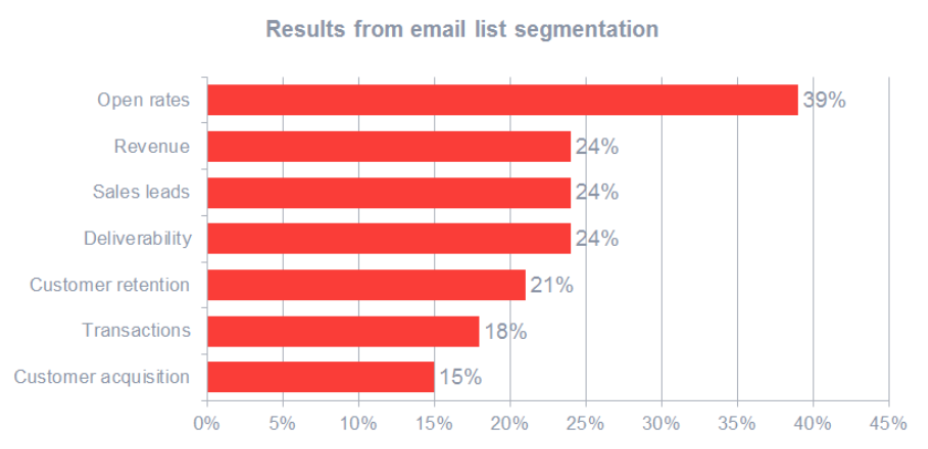
List segmentation does not have to be difficult - and it isn’t. Advances in email marketing technology easily allow marketers to create segments and blast out campaigns to one, multiple or all groups.
2. Establish clear goals for email campaigns
The next step is to think about your goals as these will dictate the types of campaigns you send and their frequency.
Your goals could include:
- Sending campaigns intended to get SMB prospects to engage with you
- Up-selling more services to current customers to help them grow
- Inviting clients in your local area to seminars and events
- Sending interesting content and thank you emails aimed at retaining and satisfying your current customers
The different types of emails are explained later in this blog, but an illustrative example is provided below.
Illustrative example: Marketing agency XYZ wants to grow, up-sell and retain customers
Marketing agency XYZ, based in Cleveland, Ohio, specializes in building websites and ecommerce solutions for SMBs, and segments its email list into the following groups:
- Prospects with no online presence
- Customers with a website
- Customers with a website and ecommerce solution
To ensure its marketing is targeted and effective, XYZ only sends emails that are relevant to the circumstances of each group.
| Segment | Messaging strategy |
| Prospects with no online presence |
|
| Customers who only have a website |
|
| High-value customers who have both a website and e-commerce solution |
|
By having undertaken a segmentation exercise, XYZ is making a positive impression that it really knows its audience and generating more business than it would have otherwise.
3. Include sign-up forms in the email marketing process to capture the right data
It can be hard to segment or send emails if you don’t have many (or any) subscribers. That’s why a crucial part of an effective email campaign marketing strategy is to implement various ways to capture email addresses.
Many marketing agencies have or would already be thinking about importing data from customer relationship management (CRM) systems and sign-up forms, in addition to data they have collected from cold-calling and existing relationships. The important considerations in this context are to capture enough data so that you can segment your mailing list and meet your goals. These could include:
- Name
- Location
- Products/services potential that clients are interested in (or have purchased)
- Industry
- Size of business
A great way to juice up your subscriber list could be to create a lead magnet and offer valuable content such as whitepapers, templates, and webinars in exchange for email addresses.
Note: You should only capture enough data as you need and ensure you are in compliance with email and data protection laws.
4. Consider the frequency of your email campaigns
Another critical consideration of your email marketing strategy is understanding how often your clients want to receive emails and your capacity to ideate, create, write, design, and test them.
Helen Holovach, localization manager at Snov Labs, has written extensively about this subject and offers best-practice tips in this blog.
“Email frequency does not get much credit for campaign success or failure, and it should. Sending too often or not often enough can destroy all your email marketing efforts, no matter how good your content, offer, or service is,” she says.
According to research from Marketing Sherpa, very few (15 percent) customers want to receive daily emails. In fact, the most popular email frequency preferences turned out to be: at least monthly (86 percent), at least weekly (61 percent), and weekly (32 percent).
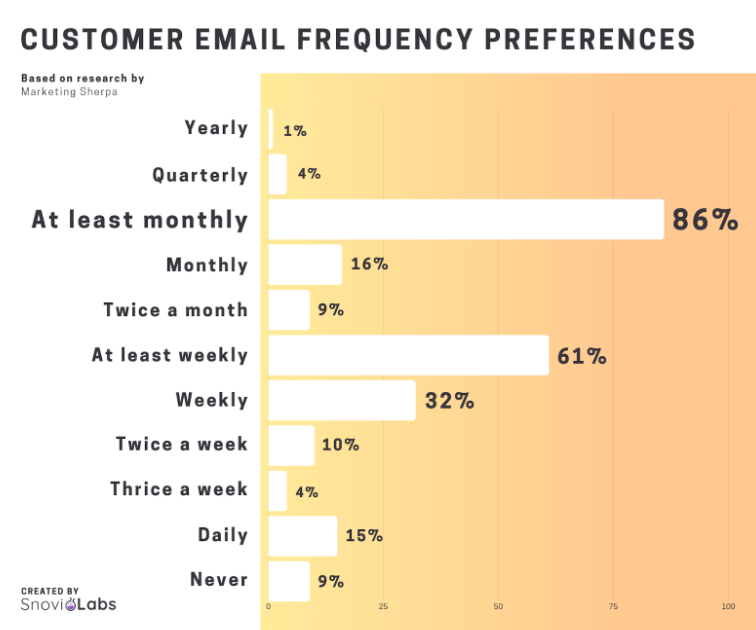
In a B2B context, most companies tend to send emails twice a month. A higher frequency risks triggering a surge in unsubscribe rates.
“Here, the old and reliable approach of one monthly update with a couple of relevant articles works just fine – this does not overload the inbox, doesn’t annoy your recipient, provides just enough value for them to appreciate your emails, and keeps you top-of-mind among loyal customers,” Holovach says.
5. Effective marketing emails are scheduled for specific times
As the old saying goes "timing is everything", and this is especially true when it comes to email marketing strategy.
Nothing frustrates a marketer more than weak open and click-through rates, which will be discussed in further detail in the next part of The Building Blocks of Email Campaign Marketing blog series.
So when are the best times to send your campaigns? Finding the magic time for your agency will take experimenting, however, there is data to support initial decision-making for this step.
For instance, a study by Get Response suggests that in the United States and Canada:
- 4 am is when open rates are at their highest, while 6 am sees the most click-through rates
- Friday is the best day for opening emails, and Tuesday is the top choice for achieving the most click-throughs
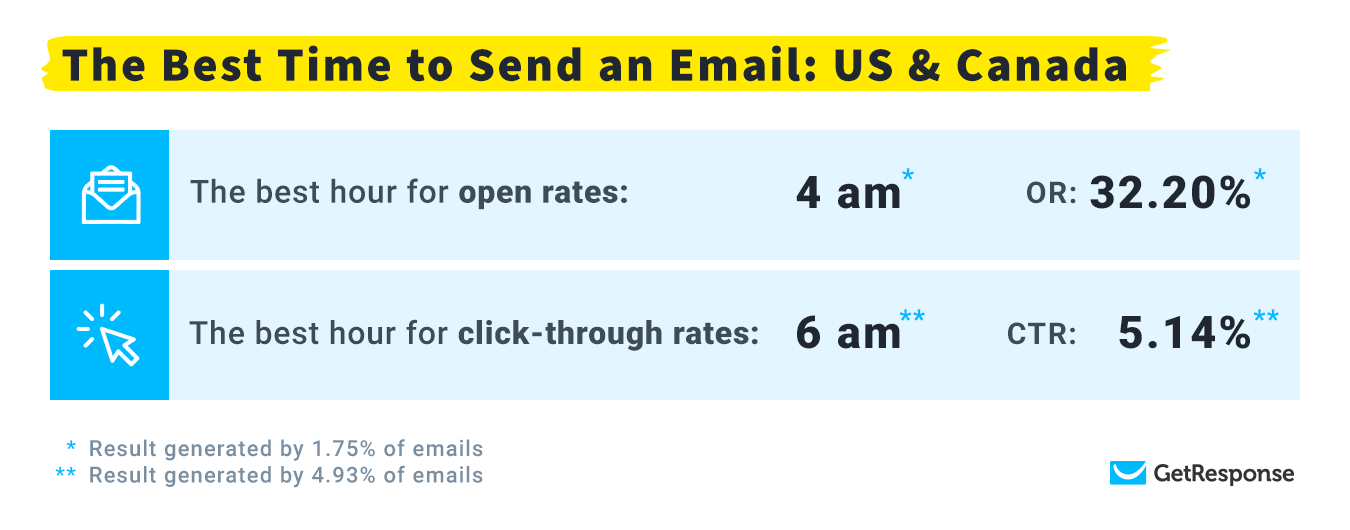
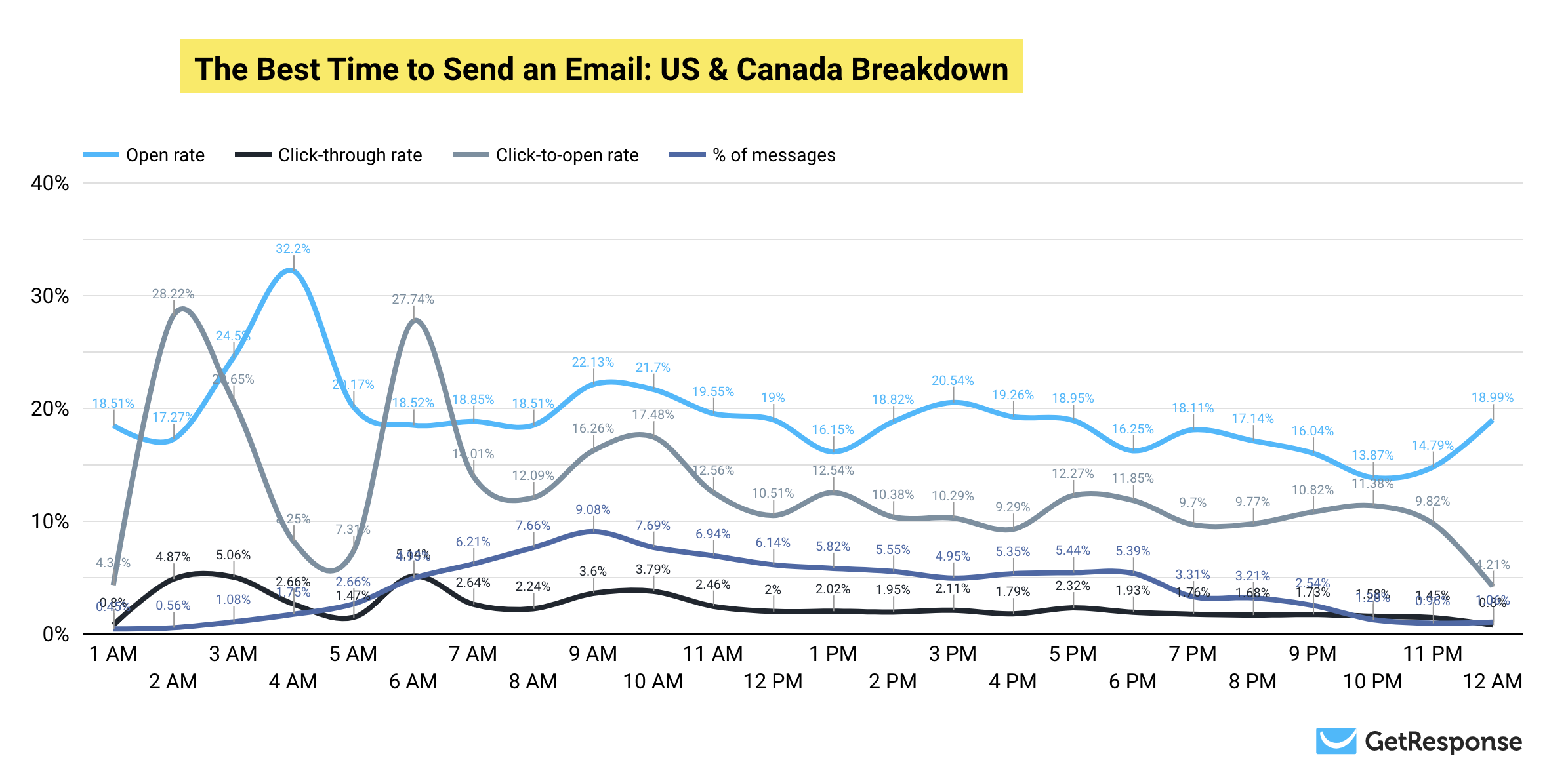
However, Holovach cautions marketers on simply basing their campaign timings on aggregated data. While data serves as a useful starting point, she suggests that agencies take into account other factors such as the industry or industries of their underlying clients and how competitors are marketing to them.
“Best practices, numbers, and stats are useful, but a solution that’s right for your business can only be found by asking yourself the right questions,” she says.
6. Create engaging, relevant, and valuable content
The rules that generally apply to content marketing are true for email marketing strategy as well. It’s important to take the time to craft copy and images that audiences will find interesting, valuable, and aligned with their expectations. Sending generic content to an email list can lead to low open and click-through rates, as well as high unsubscribe rates.
To prevent this, it can help to have clearly defined customer personas to help guide the writing process. What is your client's target customer interested in? What motivates them, and what do they care about? Emails, including their subject lines, should be tailored to this target customer.
Attention-grabbing visual elements can also help an email stand out, from images and infographics to GIFs and videos. As a bonus, they also break up large chunks of text and make the content easier to digest.
7. Test and optimize every campaign
Email campaign marketing is a process of continuous improvement. There’s always room to make tweaks and generate better results for your clients.
Some effective testing and optimization practices include:
- A/B testing: Experiment with different versions of your email campaigns to determine which elements (like subject lines, images, or CTAs) perform best. By comparing the results, you can make informed decisions on how to optimize your emails for maximum effectiveness.
- Analyze campaign metrics: Regularly review key email marketing metrics, such as open rates, click-through rates, and conversion rates, to assess the performance of your campaigns. Use these insights to identify trends and make necessary adjustments to your email marketing strategy.
- Monitor subscriber feedback: Pay close attention to any feedback from subscribers, whether through direct communication or through engagement metrics. This feedback can help you understand the audience's preferences and expectations.
- Test email deliverability: Make sure emails are actually reaching your subscribers' inboxes. This may involve addressing issues related to sender reputation, email authentication, or email content and formatting.
Types of email marketing campaigns
You have worked hard on building and segmenting an impressive email list. You have also done your homework and know all about personalizing messages and making them mobile-friendly. An important exercise in your email marketing strategy journey will be to understand which emails to blast out and for what purpose.
There are five types of emails to consider for agencies. Let’s take a closer look at how you can use these email types to better communicate to your subscribers.
Email #1 - Autoresponders
These are emails that are automatically triggered when a prospect performs an action on our website; for instance, signing up for your newsletter or downloading gated content. They are designed to acknowledge and thank a potential client for expressing interest in your company.
Best practices to consider
Vendasta’s past Director of Content Marketing Dan McLean recommends the following when it comes to autoresponders:
- Keep them to one or two sentences
- Provide a link to the report or asset they requested
- Provide links to other useful assets or the FAQ page for your business
“Autoresponders are really there to confirm that your agency has received a prospect’s request to sign up or download a piece of content from your website, but they do offer the opportunity to provide a bit more value. The key is to keep it very short,” he says.
For instance, see the following example from data solutions company GWI below.
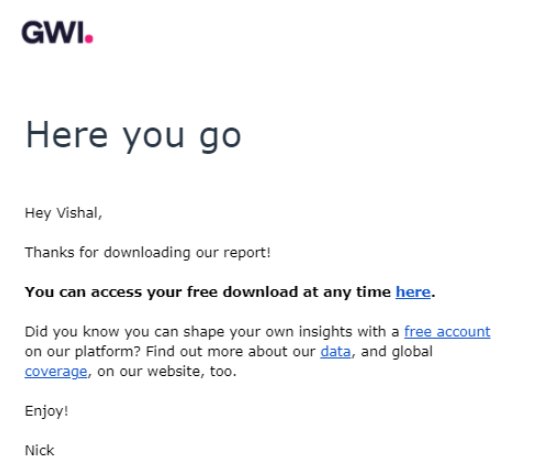
Email marketing tip: Keep your subject lines concise and attention-grabbing to increase the chances of your autoresponder email being opened.
Email #2 - Promotional emails
Promotional emails are exactly what they suggest - a campaign providing a prospect or existing customer with a deal, discount or pricing benefit of some kind.
“What you would do is set up a landing page on your website and launch what would be a promotional email campaign to the offer,” McLean says.
Best practices to consider
McLean suggests keeping promotional offers short and sharp by focusing on one or two products or services so that readers aren’t overwhelmed.
A good example is the following promotional email from the freelance services website Fiverr. Firstly, it's well-designed as it contains a banner image that is easy on the eyes. Secondly, the message is short and provides value to subscribers in the form of a discount code to be used on Fiverr's website. Thirdly, the email's messaging resonates strongly with its clientele by targeting customers and prospects who need help to get work done. Moreover, it drives a sense of urgency among readers given the sale's limited duration.
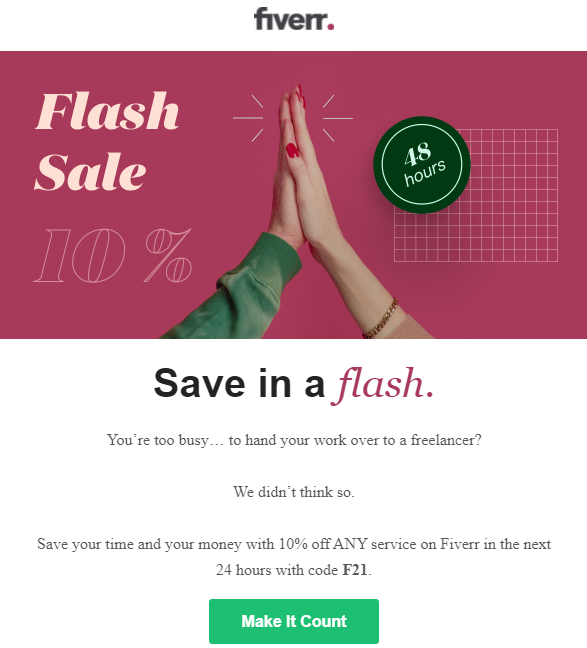
Email marketing tip: Use personalized subject lines and tailor your promotions to the recipient's preferences to increase engagement and conversion rates.
Email #3 - Nurture emails
Nurture campaigns play an important role in email campaign marketing as they target leads. They're a series of emails designed to get prospects to move along the sales funnel by providing valuable insights.
“You are serving up resources and content that takes them from that awareness stage to the consideration stage,” McLean says.
For instance, the below email from TrustedHousesitters uses content and a call to action to address a frequently asked question prospects have about the service.
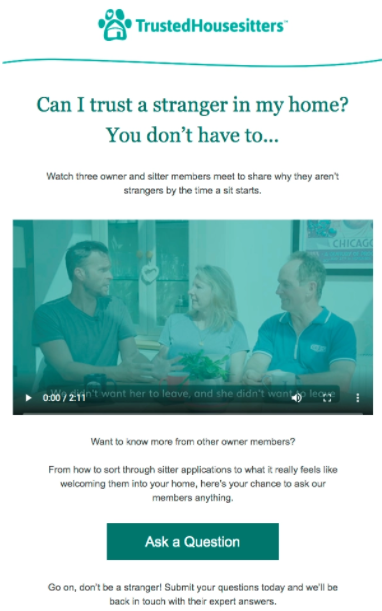
Best practices to consider
These emails are designed to provide value and should not be sales-oriented. McLean suggests:
- Creating a sequence of messages that provide different resources, tools, and case studies outlining how your agency has helped other clients
- Keeping an educational tone in the emails
Email marketing tip: Monitor the open and click-through rates of your nurture emails to understand the effectiveness of your content and make adjustments as needed.
Email #4 - Sales outreach email
Sales outreach emails are typically sent to prospects who have undergone your nurture campaign and are hopefully ready for a sales conversation.
“They are looking for a solution. They are at a point where they are likely ready to buy something. It comes from a sales professional typically and it entices them to want to reach out to them,” McLean says.
Best practices to consider
These emails and subsequent conversations should be framed around the “Why You Now?” model.
Sales outreach emails should entail a two or three-paragraph email that explains:
- Why you? The conversation begins by establishing the reasons behind your connecting with a prospect at this time.
- Why now? This speaks to timeliness and urgency and explains why they need to act now.
- Why us? This part declares your value proposition and differentiation. Here you talk about your offerings, but rather than focusing on features and functions, you tie back to the business outcomes that can be achieved.
“The idea is that you are sending a short emailing explaining that you have looked at their company or are interacting with them based on earlier sales touchpoints, putting urgency behind why it’s important for the business owner to address the challenge they are facing, and how you have created a solution that can solve that problem,” McLean says.
He adds that marketers should ensure their outreach email includes an action point to try and set up an interaction such as a meeting or call.
Email marketing tip: Use a compelling CTA that encourages the prospect to take the next step in the sales process, such as scheduling a call or attending a demo.
Email #5 - Engagement and re-engagement emails
A challenge that nearly all marketers face is dealing with subscribers who stop opening their emails. Hence, engagement and re-engagement campaigns are becoming more commonplace as a means to reignite readers' interest in the sender's business.
A re-engagement email can go by a few different names:
- Reactivation email
- Win-back email campaign
“A re-engagement campaign is a sequence of emails sent to inactive subscribers. The goal of a re-engagement email is to get people to interact with your emails,” McLean says.
Re-engagement emails can include promotions, re-state the value of your business, offer the opportunity for readers to ask questions or let them know they can change their email preferences to receive different or fewer messages.
If you’re interested in developing a re-engagement campaign, check out this blog from ActiveCampaign.
Email marketing tip: Test different subject lines, copy, and offers to find the most effective combination for re-engaging inactive subscribers.
Email #6 - Content marketing newsletters
Last but by no means the least is content marketing newsletters. These are generally weekly or monthly newsletters that provide agencies an invaluable opportunity to:
- Showcase valuable content they have produced
- Improve your authority and credibility in the audience's eyes
- Share industry news and any upcoming events or webinars
- Communicate important business updates
The key to success with content marketing newsletters is to not stuff them with content, and not make promotions the primary focus.
“A lot of companies send newsletters that are too big and have too much content. Keep it tight - provide a few great pieces of content and don’t be heavy-handed with the marketing. Remember to offer value first. If it’s just a blatant marketing exercise, recipients are going to unsubscribe. So if you want to pitch something, put it at the bottom,” McLean says.
Email marketing strategy tip: Use a clean and visually appealing design to make your newsletter easy to read and engage with, increasing the likelihood of recipients interacting with the content.
Conclusion
The key to success in email campaign marketing is for agencies and marketers to put customers at the center of their strategy.
- Segment your audience and take the time to understand the needs of and relevant messages for each subcluster
- Less is more. Resist the temptation to bombard customers with messages - once a month is a sensible starting point
- Don’t be afraid to experiment with different send times to see what works best with your audience
- Understand the different types of emails at your disposal and what makes sense to send to various segments within your customer journey
By following these steps, your SMB customers and prospects will more likely deal with you as your agency has invested the effort in understanding their needs.
[adrotate banner="216"]

